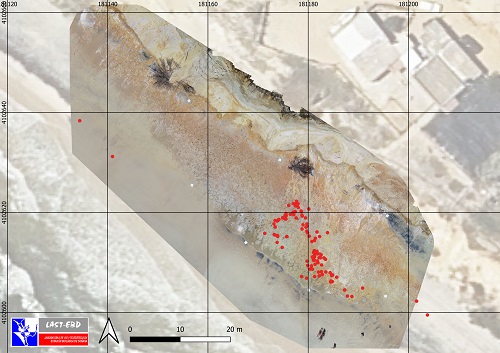Last June, a unique site was discovered by María Dolores Cobo and Ana Mateos from the Espacio Natural de Doñana on Matalascañas beach in Almonte (Huelva). In the beginning, different fossil footprints of birds and mammals from 100,000 years ago were detected. Upon further investigation, 87 footprints of human origin, specifically Neanderthal, were discovered among them. These findings have a great archaeological value since these are the oldest Neanderthal footprints of the Upper Pleistocene discovered in the whole world.
The research team that has studied the site is led by the Professor Eduardo Mayoral from University of Huelva (UHU) and is integrated by researchers from different institutions, including the Doñana Biological Station (CSIC), through its Laboratory of GIS and Remote Sensing (LAST-EBD). One of the authors, Antonio Rodríguez from UHU contacted Ricardo Díaz-Delgado from LAST-EBD to perform a drone flight that could register the site facing the imminent risk of degradation and erosion of the exposed surface by the action of the sea and the sand.
Immediately, the exposed area was flown over by a multirotor drone equipped with a visible 4K camera at two different heights (10 and 30 meters) during low tide. They obtained zenith photographs that allowed to obtain a unique orthomosaic, on which they based the identification and analysis of the Neanderthal footprints. In a few days, the site completely disappeared due to tidal movements.
In addition to the georeferenced photographic mosaic, LAST-EBD generated a topographic model that provides the relief generated by each footprint, allowing to estimate the sizes of the individuals by the depth. The researchers identify 7 footprints that belonged to children, 15 to adolescents and 9 to adult individuals. Until now, no Neanderthal footprints had been discovered in the whole Iberian Peninsula. Only one footprint had been found in Gibraltar but this was very poorly preserved and with a dating that did not correspond to the time in which the Neanderthals lived in the area.
According to professor Eduardo Mayoral, the action of waves and tides makes it difficult to study the site, although it could indicate that it extends to the beach of Mazagón since they have found some footprints that pointed in that direction.
The next step will be to carry out more exhaustive studies on the composition of the group, their ages, their sex and the researchers will even try to deduce what they were doing at the time. The study concludes that it is not a transit or migration zone and there could be a nearby settlement. The footprints have been found on the shore of a now-disappeared lagoon, so, according to the professor, the group of Neanderthals that left their footprint may have been fishing or hunting. Everything indicates that Matalascañas beach could be a shellfish area frequented by Neanderthals.
Reference
Eduardo Mayoral, Ignacio Díaz-Martínez, Jéremy Duveau, Ana Santos, Antonio Rodríguez Ramírez, Juan A. Morales, Luis A. Morales y Ricardo Díaz Delgado. Tracking late Pleistocene Neandertals on the Iberian coast. Scientific Reports. 11, 4103 (2021). https://doi.org/10.1038/s41598-021-83413-8
https://www.nature.com/articles/s41598-021-83413-8








 ¡Abierta convocatoria para proyectos de investigación en la ICTS- Doñana!
¡Abierta convocatoria para proyectos de investigación en la ICTS- Doñana!


